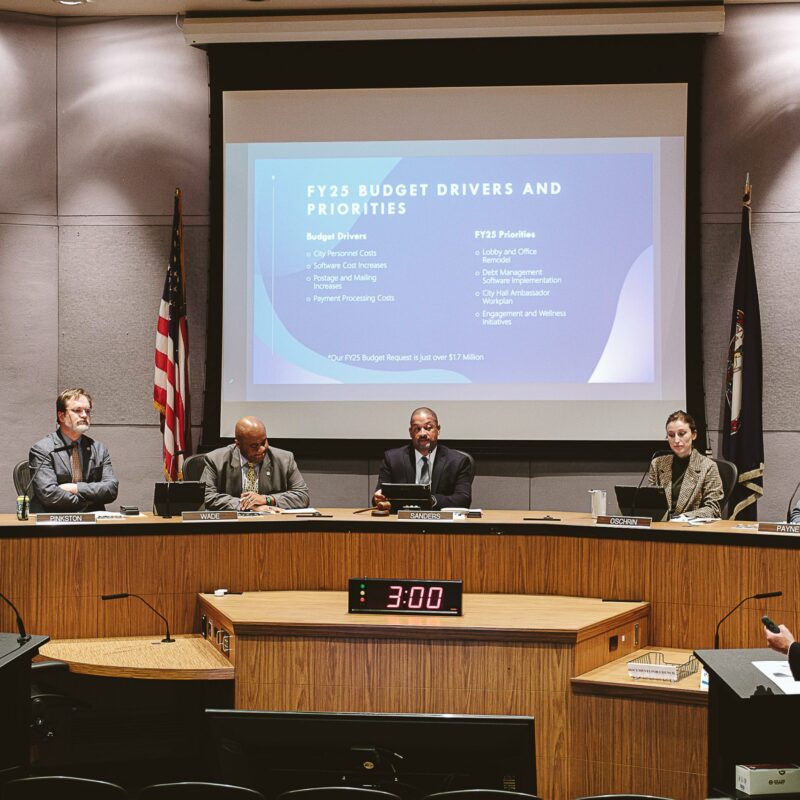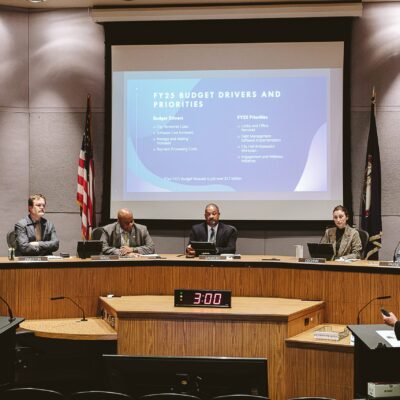The National Ground Intelligence Center (NGIC) is a fortress at once impregnable and approachable. Looming over Route 29N, it invites inspection but at the same time is mysterious. What is that up there?
What it is: One of the Army’s main intelligence branches, NGIC’s specific purpose is to gather information on America’s opposing armies. “We cover everything from mud to helicopter,“ said Captain Chris Pulliam in describing their purview. They regularly amass intelligence on conventional enemies, like China, North Korea, and—I was surprised to find—India.
The Center itself was opened on September 15, 2001. The attendant ceremony was scaled back. America was under attack. There was work to be done.
Al Qaeda changed everything. Now NGIC has a two-fold mission. In addition to conventional forces, staff now focus on irregular threats, so-called insurgents and their tools, like the Improvised Explosive Devices (IEDs) that routinely blow up our soldiers in Iraq. NGIC’s plan: “Defeat the device, defeat the system, train the force.”
NGIC was created in 1994 with the merger of two agencies, the U.S. Foreign Science Technology Center and the U.S. Army Intelligence Threat Analysis Center (ITAC). The FSTC was already based in a building opened in 1965, downtown before there was a Downtown Mall (SNL Financial now calls it home). When the two agencies were consolidated, the building was an uncomfortably tight fit—not to mention too close to the burgeoning downtown—so they sought refuge out on Route 29N on Wendell Wood’s land.
Now they are undergoing a similar shift, as NGIC makes way for the installation of the Joint Use Intelligence Facility and its 828 Pentagon personnel. NGIC is also likely to expand and you can see why. Boulder’s Road is lined with automobiles, stacked side by side and winding up the way. Their current home was built for a little over 700 employees, but now they hold over 1,200.
The business of war is an expanding market; a new enemy means a boom. Still, NGIC has not been without its growing pains. A commission set-up by the president to look into what went wrong with Iraq offered a harsh assessment of a claim attributed to NGIC. Colin Powell used it in his crucial address to the U.N. on Iraq, mainly that Saddam and his minions had acquired aluminum tubes that would project WMDs. Nowhere and everywhere. The Robb-Silverman presidential commission ripped NGIC for “gross failure” in their munitions analysis.
It only got worse. Around the same time, questions were raised by The Washington Post writer Walter Pincus about the center’s highest ranking civilian at NGIC, a son of his, and a company called MZM, under fire itself for president Mitchell Wade who was caught bribing Randy “Duke” Cunningham, a Californian congressman, with all sorts of things, including a mansion and a yacht, rechristened “The Dukester,” appropriately enough.
“Two months after MZM Inc. was given its first order in October 2002 to perform services for the Army’s National Ground Intelligence Center (NGIC),” Pincus wrote, “the company hired the son of the center’s senior civilian official, Executive Director William S. Rich Jr., according to present and former Intelligence Center employees.” The article alleged all kinds of impropriety, contributing to a foul smell that still lingers. Countermeasures have been taken to keep “stove-piping” from happening again, Capt. Pulliam assured me.
I don’t doubt him. NGIC is an impressive place, as I found one afternoon when I was treated to a tour by Capt. Pulliam and the man getting ready to take his job as executive officer, Lieutenant Jeff Alexander. I sat at the head of a large oak table, flanked by the two soldiers, in the Company Commander‘s board room and stared at a flat computer screen disseminating facts. For instance, did you know that the majority of NGIC’s workforce is mostly made up of civilians (647) and contractors (524)? There are only 138 active military with the reserves supplementing 74.
Or that they had almost 13,000 visitors last year, an average of 1,068 per month? It is no surprise then that Wendell Wood has a hotel planned for his adjoining parcel due to become a Development Area.
NGIC also helps out at home. Hurricane Katrina was classified as an opposing force as it approached the Gulf region so NGIC provided images of chemical plants at risk of spills. They also provided emergency aid in the clean-up after the 2004 tsunami in the Indian Ocean. I don’t exactly know why.





